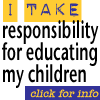
History of honest and dishonest education in Colonial America and the United SatesMany Americans have an aversion to history. Perhaps this was acquired by the way history is taught in most schools, that is, the memorization of dates and names without much concern for learning the lessons we can learn. As a result, most people's sense of history is only what has happened in their lifetime.If you want to get a quick thumbnail sketch of why and how Americans in the 1840s turned their backs on 220 years of Honest Educationduring which they birthed the American Republicplease click here. You'll see just the tip of the iceberg of religious bigotry of the time that fueled this massive shift in the American soul. For the first seven generations of Americans, that is, from the 1620s until the 1840s, almost all schooling in the colonies and in the early United States was Honest Education. People of various beliefs made sure their children were schooled either at home or in schools that supported their particular religion or world view. We still use this approach in sports and church. Different sports teams practice and play on a field, court, or pool that supports their game, be it football, baseball, basketball, soccer, diving, swimming, ice hockey, field hockey, or fencing. Similarly, the Buddhist or Baptist, Catholic or Calvinist, Jew or Muslim, Mormon or agnostic, etc., each take their children to religious or ethical activities that support their belief system. It seems to work well. Blacks and whites worship together, but Baptist and Buddhist do not. Sunday at 11:00 a.m. is the most peaceful hour in America. In the 1840s, however, Americans broke with their educational tradition and adopted "common schooling" whereby children of different faiths were put in classrooms together. The reasons were many and are described elsewhere in this website, but the gist of it is that several special-interest groups wanted to have the government take over the private schools. In some ways it was quite similar to the Soviet approach to farming in the 1920s and 1930s: Replace private farming with collective farm-by-government. If helping the poor had been the real motive of the 1840s' promoters of politician-controlled schools, they simply would have paid tuition for the poor to attend the many private and church-run schools. But our education historians tell us that religious bigotry was rampant in the 1840s and the motives of many were rooted in prejudice. Hence they chose to collectivize the schools rather than fund schools run by churches that were "politically incorrect" at the time. (For example, read about the Philadelphia Bible Riots of 1844 http://www.google.com/search?num=50&hl=en&lr=&ie=UTF- 8&oe=UTF- 8&newwindow=1&as_qdr=all&q=+1844+%22philadelphia+bible+ riots%22&btnG=Google+Search.) Thus began our 160 year gradual "dis-integration" of what we call "public schools." While in the 1950s to 1970s Americans ended the racial segregation of schools, we went the opposite direction by further segregating moral instruction from academics.
[top] |

